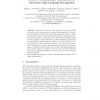Free Online Productivity Tools
i2Speak
i2Symbol
i2OCR
iTex2Img
iWeb2Print
iWeb2Shot
i2Type
iPdf2Split
iPdf2Merge
i2Bopomofo
i2Arabic
i2Style
i2Image
i2PDF
iLatex2Rtf
Sci2ools
103
Voted
GW
2009
Springer
2009
Springer
Influence of Handshape Information on Automatic Sign Language Recognition
Research on automatic sign language recognition (ASLR) has mostly been conducted from a machine learning perspective. We propose to implement results from human sign recognition studies in ASLR. In a previous study it was found that handshape is important for human sign recognition. The current paper describes the implementation of this conclusion: using handshape in ASLR. Handshape information in three different representations is added to an existing ASLR system. The results show that recognition improves, except for one representation. This refutes the idea that extra (handshape) information will always improve recognition. Results also vary per sign: some sign classifiers improve greatly, others are unaffected, and rare cases even show decreased performance. Adapting classifiers to specific sign types could be the key for future ASLR. Key words: sign language, automatic sign language recognition, handshape representation
Related Content
| Added | 18 Feb 2011 |
| Updated | 18 Feb 2011 |
| Type | Journal |
| Year | 2009 |
| Where | GW |
| Authors | Gineke A. ten Holt, Marcel J. T. Reinders, Emile A. Hendriks, Huib de Ridder, Andrea J. van Doorn |
Comments (0)

